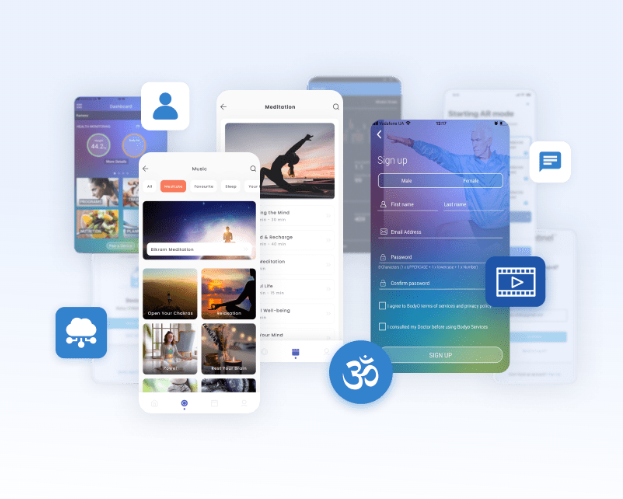The demand for wellness solutions continues to grow, and meditation apps have become a popular tool to manage stress, promote mindfulness, and support mental health. However, in a competitive landscape, simply offering guided meditations is no longer enough. To truly stand out and drive user retention, artificial intelligence (AI) and personalization are becoming essential components of modern meditation app development.
In this article, we’ll explore how AI and personalization are transforming user experiences in meditation apps, the benefits they bring, and how to effectively integrate them when you decide to build a meditation app.
The Importance of Personalization in Meditation Apps
Every meditation journey is deeply personal. What relaxes one user might not work for another. That’s why generic, one-size-fits-all meditation content often fails to engage users long term.
Personalization ensures that users receive content, recommendations, and features that align with their goals, emotional states, and habits. When done right, personalization helps users:
- Build consistent meditation routines
- Achieve faster results
- Feel understood and supported
- Stay engaged for longer periods
And this is where AI becomes a game changer in meditation app development.
The Role of AI in Meditation App Personalization
AI can collect, analyze, and act upon user data to deliver an experience that adapts to each individual. Here are the main AI-driven personalization strategies used in successful meditation apps:
1. User Behavior Analysis
AI tracks user behavior such as:
- Time spent meditating
- Preferred sessions (e.g., sleep meditations, breathing exercises)
- Frequency of app usage
- Drop-off points
This data is used to predict what the user is likely to enjoy next. For example, if a user frequently chooses body scan meditations in the evening, the app can automatically recommend similar sessions around that time.
2. Emotion Detection and Sentiment Analysis
Some apps now integrate AI to analyze text-based mood check-ins or even voice tone to understand a user’s emotional state. Based on this, the app can tailor recommendations:
- Calm, grounding meditations for stress or anxiety
- Energizing sessions for fatigue
- Gratitude practices for low moods
This type of intelligent content curation allows for a more empathetic and responsive app experience.
3. Natural Language Processing (NLP) for Chatbots and Recommendations
AI-powered chatbots using natural language processing can guide users through their meditation journeys. These virtual assistants can:
- Suggest content based on conversational prompts
- Answer questions about meditation techniques
- Help users set and achieve goals
For example, if a user says, “I’m having trouble sleeping,” the chatbot can recommend a sleep-focused meditation program or play soothing audio in the background.
4. Smart Notifications and Reminders
AI optimizes push notifications by learning when users are most receptive. Instead of generic reminders, users receive personalized nudges like:
- “Ready for your afternoon mindful break?”
- “You’ve been doing great with evening meditations — keep it going!”
This improves engagement without being intrusive or annoying.
5. Custom Meditation Journeys
Advanced apps allow users to embark on guided journeys tailored to their evolving needs. AI helps adjust the sequence of sessions, duration, and difficulty based on user feedback and performance.
For example, a beginner might start with 5-minute sessions focused on breathing, while more experienced users can dive into longer, theme-based practices.
Examples of AI in Leading Meditation Apps
Several popular apps are already leading the way in using AI and personalization:
- Headspace uses behavioral insights to create personalized content pathways.
- Calm leverages AI to offer mood-based session recommendations and tailored sleep stories.
- Aura adapts content from multiple therapists and coaches based on AI-driven emotional analysis.
- Sattva uses biometric data from wearables to recommend the right type of meditation.
These innovations reflect the broader shift in building a meditation app that feels more like a companion and less like a generic tool.
Key Benefits of AI and Personalization in Meditation Apps
1. Increased User Engagement
Tailored experiences are more likely to resonate with users, leading to higher daily usage and app retention rates. Users feel like the app “knows” them, which boosts loyalty.
2. Improved Mental Health Outcomes
By offering the right content at the right time, AI-powered personalization helps users stay consistent with their practice, improving their emotional regulation, sleep, and stress levels.
3. Data-Driven Product Improvements
AI provides developers with insights into what users want, which features are popular, and where they drop off. This information is invaluable for future updates and roadmaps.
4. Competitive Advantage
Personalized meditation apps stand out in a crowded market. With more than 2,500 wellness apps in the App Store alone, offering a smart, adaptive experience can be your key differentiator.
Challenges and Considerations
Despite its advantages, integrating AI and personalization into meditation app development comes with challenges:
1. Privacy and Data Security
Personalization requires data — often sensitive data like mood, voice input, or sleep patterns. It’s critical to implement:
- End-to-end encryption
- Transparent privacy policies
- Compliance with regulations like GDPR and HIPAA
Building trust is paramount.
2. Avoiding Over-Personalization
Too much personalization can feel invasive or limit content exploration. Balance is key — offer recommendations, but leave room for discovery.
3. Bias in AI Models
If your AI models are trained on limited datasets, they may not serve diverse audiences effectively. Ensure inclusive data training to make the experience universally accessible.
4. Cost and Complexity
Adding AI capabilities increases the technical complexity and cost of development. Working with experienced teams specializing in meditation app development is essential to ensure smooth implementation.
Steps to Integrate AI and Personalization into Your Meditation App
If you’re ready to build a meditation app that’s personalized and AI-driven, here’s a step-by-step approach:
Step 1: Define Your Goals
- What kind of personalization do you want?
- Are you targeting beginners, experienced users, or a specific demographic?
Your goals will determine which AI features to prioritize.
Step 2: Gather Quality Data
You’ll need a data pipeline to collect and process user behavior, preferences, and feedback. Make sure it’s structured, anonymized, and compliant with data protection laws.
Step 3: Choose the Right AI Tools
Consider frameworks and APIs like:
- TensorFlow or PyTorch for machine learning
- GPT or BERT for NLP tasks
- Dialogflow or IBM Watson for chatbot integration
Step 4: Build Dynamic Recommendation Engines
Create systems that adjust content suggestions based on real-time data. Use A/B testing to refine your algorithms.
Step 5: Develop Emotion-Aware Interfaces
Allow users to check in emotionally via text or voice. Use sentiment analysis to power suggestions and responses.
Step 6: Integrate with Wearables (Optional)
If your users are tech-savvy, consider integrating with Apple HealthKit, Fitbit, or other devices to gather biometric insights and enhance personalization.
Step 7: Focus on UX and Transparency
Make sure users understand why certain content is being recommended. Add opt-in/opt-out options and educational popups to improve trust.
Final Thoughts
As users seek more meaningful and effective meditation experiences, the integration of AI and personalization is no longer optional — it’s the future of meditation app development. By understanding user behavior, mood, and preferences, your app can deliver a uniquely supportive and responsive experience.
Whether you're in the early stages of building a meditation app or enhancing an existing one, investing in AI-driven personalization will not only improve user satisfaction but also set your product apart in a crowded marketplace.
Are you ready to build a meditation app that truly understands and supports your users? Partnering with the right development team, experienced in both wellness tech and AI integration, can make all the difference.

